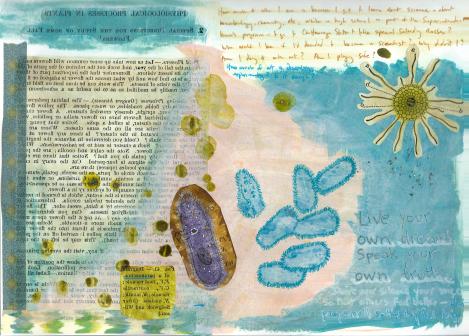October is about stripping away, of seeing beauty in decay, of letting go. It is about seeing things in new ways, when the trees lose their leaves and reveal their bones.
For this, I’m using a lot of leftovers and pieces I’ve accumulated. Nothing is expensive. It reminds me of how I got my start buying beads at the nearby thrift store and broke them up to make my first necklaces. I could buy a necklace for a quarter, redesign it with a few new beads, and sell it for $15. People don’t appreciate the time or creativity involved in making art, so it is better to not pay too much for materials.
The canvas was bought at Goodwill – already painted. This is a great way to buy a canvas – instead of $40 to $50 for a 24 x 30 inch canvas, this was $15. You can always paint over it. This too is part of the process of letting go – of not feeling I have to keep everything like it is. Change is essential for growth, and letting go is part of that.
This is what was on it.

I found gauze at Target for $1. I actually got it free because my husband had gotten a $5 gift card because he gets his prescriptions filled there. I’ve heard about using gauze as texture – time to try.

I painted the canvas with a thin coat of gesso, and affixed the gauze with it.
I’m not very good at putting on gesso yet. But maybe I should use a regular bristle brush and not a foam brush. Most of my bristle brushes are small – not suited for gesso. This is a new experience for me. Here I’m playing with texture.

I didn’t entirely cover up the image that was already there. I think it is nice to show what came first, the origin of the piece. You can never fully erase your past – it is always with you, even if you don’t see it.

This was paper I got from Yankee Candle – they’d wrapped up my large jar candles in it. I spritzed it with Tim Holtz “Distress Ink” spray stain and a few spritzes of water. I made this last week, not sure what I was going to do with it. I tore it into pieces, saving the parts I liked best. The remaining pieces I’ve already sprayed with more color and will use later (maybe in this project).

It is darker on the canvas because it is still wet with matte medium (coated front and back). Perhaps I’d have been better not painting the front with matte medium, since I might put acrylic paint over some of it. We’ll see. This is an exercise, a practice. Mistakes are valuable opportunities for learning.
Detail – some of it tore while I put it on the canvas. I’ve added a little gesso too.

I like this dead moth. I found it in a windowsill at work. I picked it up and saved it with a label protector. Things die in October. They have to. This moth is a reminder that time is precious, yet also not to take it so seriously I forget to live life.

Here is the assortment of papers I intend to use – leftover bits from tissue paper and bags from items I’ve bought, and bits from other projects. I like the saying on the bag I got from the Hallmark store in Boone, NC when I got some rainbow pencils. It is a little large, so I might just write this on the canvas when I’m done. Right now it is nearby as inspiration.

These are the Asian-language instruction pages from a tiny Moleskine journal I found at a used book store in Knoxville. I tore them using a metal ruler as a straightedge.

This is a subset – a collage within the collage. I plan to put it in towards the end, but assembled it first. Some of the pages with words are from Robert’s Rules of Order – I got it for free. I’m not sure how I made the back. I definitely used Distress Spray Stain, but it reacted with the paper in an odd way. I’m pretty sure I couldn’t replicate it.

I added the moth I found to it.

Then I underlined some of the words in gold gel pen.

I might use some of this. This is tissue paper that I had under other things that I was spraying. The empty spaces are where they were.

This is at the end of day one.

(Day two)
Here, I’ve painted some of the corners and edges with acrylic paint, daubed on with my fingers. It is a blend of White with water, Phthalo green blue, Olive green. I’ve used these colors on my bathroom door. They remind me of the color of rust and I’m told it is the color of Parisian municipal things – benches, street lamps, grates. It is the color of rain and mist.

detail –

I’m sorry some of the pictures are so dark, thus the colors aren’t true. I was working in my craft room which is on the North side of the house, and it was about an hour before sunset on day one, and an hour after sunrise on day two. I could see fine, but the camera thought otherwise. Maybe one day I’ll have an assistant and a professional studio, but for now, this is what you get. That too is part of the art – of using what you have without fear.
When I work more on this, I’ll add it all here rather than make separate posts.





















 When I transcribed the quote, I wrote it as
When I transcribed the quote, I wrote it as







































You must be logged in to post a comment.